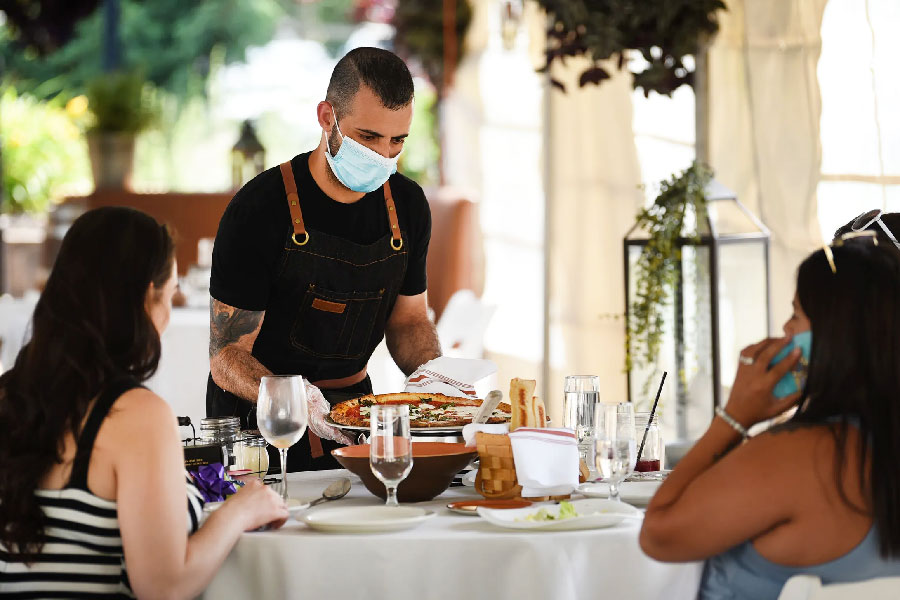Pandemic dining: Restaurants prepare for an unforeseen post-script
Dine-out restaurants have reason for cheer as Maharashtra allows reopening and New Delhi announces easing of restrictions. But despite progressive lifting of lockdowns, business for restaurants has remained a fraction of pre-COVID levels. Moreover, deliveries are expected to dominate and restaurants may be driven towards more healthier and immunity building items in their menus.

Image credit : https://njersy.co/35a2ovE
- The hotel and restaurant industry has been craving for a stimulus package and support from the government as the lockdowns shut their businesses. Progressive easing of restrictions has also not had the desired impact on business. According to a report by Zomato in August 2020, 10% of dine-out restaurants have shut down across India in the post-pandemic phase, while 30% more are unlikely to reopen even post the pandemic. The rest of the dining industry is just operating at 8-10% of GMV levels.
Easing of restrictions in two key markets – Mumbai and New Delhi – offers hope for a revival of the industry. The government of Maharashtra has permitted restaurants to reopen on October 5. The Delhi government has recently announced 24×7 opening of the restaurants and abolished the tourism, health trade and police licenses. More decisions regarding rules to remove extra fees imposed on services in open areas, verandahs, and balconies and permission to brand inside the restaurant, for playing all types of music including DJs, karaoke, and live bands, and to keep stock of alcohol anywhere in the premises were also taken. The mandatory requirement is the undertaking that restaurants will take care of the security and safety of their employees.
Revival of the restaurant industry is critical to overall revival of the economy. As per the National Restaurant Association of India (NRAI) the industry accounts for Rs. 4 lakh crore turnover and employs about 7.3 million people. Around 30-40% of these are contractual staff who were mainly hit by the layoffs that took place amid the lockdown.
Now 24 hours reopening will call in more customers and more dishes on the menu. Operations were restricted only to lunch hours during Unlock 4.0 when 9 pm was the set as the closing time. As a majority of sales took place after 9 pm, restaurateurs are hoping for an upsurge in sales with 24 hrs. reopening.
The lockdown phase has seen restaurants make major strategic adjustments for survival. Quick service restaurants (QSRs) like McDonald’s and Burger King saw a severe decline in their orders, so they channeled sales through Swiggy and Zomato. Lesser orders during the pandemic season meant that more than 50-70% of revenue had to be covered from deliveries. Burger King intends to open its own app that contains a feature ‘zero contact dining’ in which customers can visit, pay through the app and avoid queues and physical contact.
Restaurateurs realize that the recovery is uneven and it might take around 12-18 months to return to normal, even after the vaccine is developed. In Goa for instance, a sudden upsurge of cases made people cautious. Despite the lifting of the ban from September 1, restaurants were virtually empty, except for some non-Goan customers. Some food joints in Goa started their small culinary enterprises. In other parts of India, people are commonly setting up localised food joints, at times from the comfort of their homes.
Now, the industry will not be the same due to a lack of money in the hands of people due to the job losses COVID has brought in. In the words of Dr. Venkatesh Shankar, Professor of Marketing and Coleman Chair in Marketing and Director of Research at the Center for Retailing Studies, Mays Business School, comments:
Consumers are getting used to online ordering and delivery—they are warming up to the convenience. They are also wary of shopping in crowded stores, eating in packed restaurants, or hanging out in busy malls, theatres, and stadia. They are also caring more about cleanliness and sanitation while shopping. They will trust and embrace brands who appear to incorporate these revised attitudes and behaviours in their marketing and be stewards of society.
Initial response in Mumbai is pretty lukewarm, as customers are wary of even things like air conditioned rooms and choose to stay away. Only 30% of restaurants are expected to open initially, with the rest expected to open over a month. The biggest challenge for these restaurants is accommodation and transportation of their staff.
As sectors adapt to work-from-home and consumers remain itchy towards eating out, food deliveries will continue to have an edge. Demand for outside food may also reduce as people might have learned preparing healthy alternatives at home. Another challenge is adapting to the new dietary choices of people – a shift to a healthy diet has also compelled restaurants to diversify into healthy menu choices and immunity building foods.













In this case of reopening of restaurant business , what is the position of Cloud Kitchen style business ? Will it further grow and how much ?
Thanks.